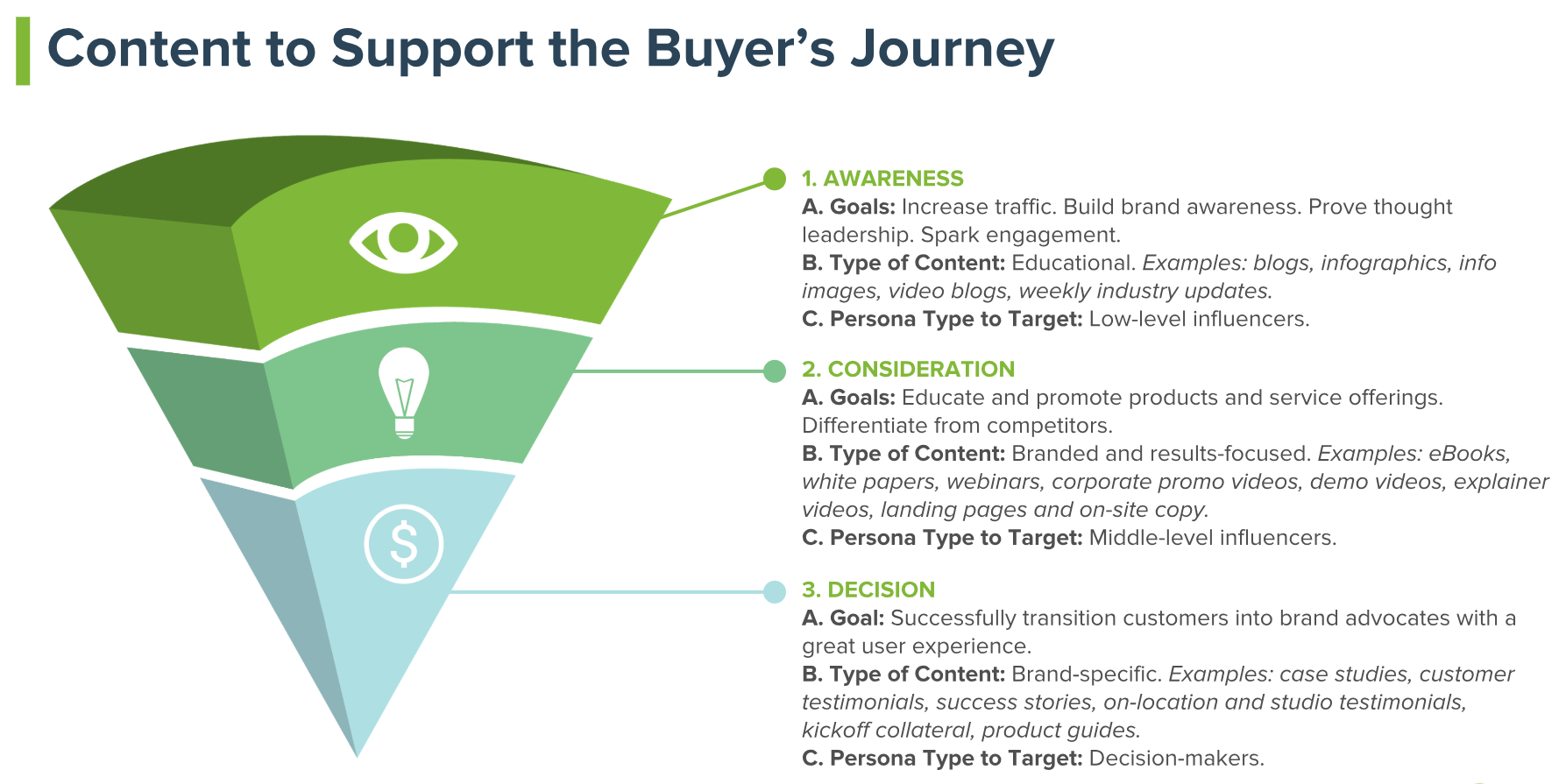Your blog isn’t what you think it is.
It’s not a forum for company press releases. It’s not a soapbox for your CEO’s random thoughts. It’s not even where you generate leads.
A blog is simply a portmanteau of “web+log.” It’s a page to record topics of interest relevant to your industry — not the great American novel. Blogging is meant to create top-of-funnel traffic by taking a stance on meaningful industry conversations, addressing pain points for your target audience and making stuff interesting.
So let’s talk about your actual content creation and blog marketing strategy.
Where Blogging Fits Into the Marketing Funnel
There’s really no secret reveal here. A marketing blog is designed to live at the top of the funnel, where site visitors are still in the Awareness stage and are simply searching for information.
Their motives aren’t yet clear. Could a high-value buyer currently be reading your blog? Could they be comparing your offerings to your competitors’?
At this point in time, and looking at blog performance alone, it’s tough to tell.

As the handy graphic above shows, your blog content should use an educational approach without being salesy or overtly promotional.
The only way to learn more about your visitors and their intent is to move them further down the funnel to the Consideration stage. Here, they may trade their contact information for gated assets like eBooks or white papers.
How Blogging Fuels Your WHOLE Marketing Strategy
Although companies often think of blogging as a surface-level, elementary component of marketing, it’s more important than many believe.
That’s because the blog is often the easiest way prospects can begin interacting with your brand. It’s their first impression of your digital marketing strategy — and for that matter, your brand as a whole — which means it needs to pack a punch.
Few people dive directly into a 30-page product brochure or sign up for an hour-long webinar without first perusing your blog content. And since blogging is the tip of the inbound marketing spear, you can maximize your content ROI by distributing your work through your online channels.
Email Marketing
Are you sending emails to your subscribers and prospects? If so, what are you actually providing them?
Hopefully, it’s something of value — like a newsletter, a compilation of top blogs or an opportunity to learn more about your company. Formatting the body of your emails with teaser text from your blogs, clickable calls to action (CTAs) and other forms of media allows you to interact with potential leads in new, off-the-page ways.
By consistently sharing blog content (and other kinds of content that engage your target audience), you’ll remain top of mind when it really counts. Prospects will think of you, your blogging and your top-notch emails if and when they move into the Consideration or Decision stage.
Social Media Marketing
If you’re managing social posts on multiple marketing channels, you’re not recycling the exact same content with the exact same verbiage — right? Why are your eyes darting?
Okay, okay, enough with the guilt-tripping. The good news is that a solid social media strategy can be supported by an even stronger blogging strategy.
Why? Simple: Social media is the natural extension of the blog marketing lifecycle. Observe:
- Write a blog.
- Publish a blog.
- Promote a blog.
(Told you it was simple.)
The key is to share the types of blogs that your specific social audiences will share (or comment on).
That could look something like this:
- LinkedIn: Linking to longer-form blog content and soliciting responses from followers.
- Twitter: Featuring a strong visual, a quote from a blog and a truncated link to the full-length post.
- Facebook: Sharing a more provocative/trending news piece to generate reshares.
Blog Content for SEO
Your content strategy is no strategy at all if you’re not creating blog posts specifically for organic search.
Search engine optimization (SEO) helps shape and inform your blog content, telling you what you should write about based on what users are actively searching for. Plus, blogging gives you an opportunity to target longer-tail, non-commercial keywords that could be relevant to a wider audience. For example, “why won’t my car start” has no commercial intent, but if you write a blog with that keyword, users will already know you and your services if they go to search for “car mechanic near me.”
More than half of all web traffic (51%) comes from organic search. The only way to capture that organic traffic is to appear in search engine results pages (SERPs) — and the only way to do that is to make sure you have content that readers and search engines alike will actually pay attention to.
All this is to say that SEO is your primary vehicle for getting your blog content in front of viewers. Your blog content, meanwhile, can be a powerful means of enhancing your site’s overall presence on search. There is a near-endless number of informational and “how-to” keywords to target. Blog content is your primary tool for targeting, and ranking for, those keywords. Do it right, and you’ll keep driving new traffic to your site. In this way, your blog can empower your SEO.

Linking Strategies
Internal and external links are a big part of your SEO success. They help search engines understand what you’re talking about, how reliable you are and how relevant your content might be. That means you need plenty of opportunities to link to your own pages and third-party sources — and blogging makes it easier than ever. For example, you could link to reliable external websites when sharing stats or use previous blogs to support new points.
Subscribe to
The Content Marketer
Get weekly insights, advice and opinions about all things digital marketing.
Thank you for subscribing to The Content Marketer!
Other Big Benefits of Blogging
Memorable blogs can be more than a content marketing strategy. When done properly, they’re a market differentiator, particularly for companies that don’t stand out much from their competitors in terms of products or pricing.
If a small business with a regional focus distributes geotargeted blog content, several things happen:
- That business appears more prominently in SERPs.
- That business may be more likely to win high-value local deals.
- That business has a tangible offering to provide prospects that competitors do not.
Let’s take a look at some of the other things you can expect from great content and a well-crafted marketing blog:
Branding
Blogs don’t need to be heavily branded, but they do need to consistently align with your overall brand image. Over time, your blog page reflects the brand characteristics you project to the marketplace — for example, quality, authority and expertise.
Customer Service
Customer experience is everything, and that includes time spent on your site.
But think of how many phone calls you receive and the types of reviews customers leave online. Wouldn’t it be great to answer questions via a how-to blog post or even an FAQ-style resource? Not only will these pages perform well in search, but they will also allow you to serve valuable information without having to pick up the phone or respond to an email.
The information is already there on your site. And it’s evergreen.
Flexibility
Speaking of customer service, have you ever thought how nice it would be to offer content based on a customer’s exact needs? Maybe you’ve wished you could deliver answers for a specific area in the sales funnel or help retain existing customers without excluding anyone who hasn’t yet made a purchase.
Blogging can make that happen. Why? Well, blogs are easier to plan, create and publish than some other kinds of content, which means it takes fewer resources to make a whole bunch of them. That, in turn, means you can have blogs catering to every little part of your target audience — and, better yet, you can create categories so users select the most relevant content for their needs.
Sales Enablement
Business owners care about a lot of things, but one of the biggest is deals. How many deals are coming in? Are customers coming back for more? Is there any way to boost those numbers?
Luckily, that’s where blogging comes in.
Blog marketing is a key tactic for sales enablement because it provides sales reps with easy-to-use collateral to distribute or refer back to at all times. At each stage of the buying process, prospects require some form of nurturing via content — a process that begins with blogs.
Blogging should also do some of the heavy lifting in communicating your industry authority to speed along the sales process. If you’re not blogging, your competitors are out there shaping the opinions of buyers while you sit on the sidelines.

Thought Leadership
Want to present a new idea, show off your industry experience and give your target audience something to think about — all at the same time? Thought leadership blogging is the perfect place to start. That’s because thought leadership establishes credibility through clear, valuable and original discussion. This doesn’t just give readers the opportunity to learn more about you and how good you are at your job; it also puts a fresh thought in your audience’s heads — one they’re far more likely to associate with you than some generic point that could just as easily belong to the competition.
Multichannel Marketing
If you’re hoping to get the most out of multiple marketing channels, you should start with a blog. Why? A blog is a great way to create foundational content for all those other platforms — especially social media. For example, a single 2,500-word blog can inspire dozens of social posts, an infographic or two, an explainer video and more.
Tracking Blog Content Performance
All of your marketing campaigns should be rooted in data. To blog successfully, you’ll need a solid understanding of what to write and how to know it’s working.
Choosing Topics
How can you figure out what your target audience cares about at any given time? Try these tips:
- Assess the keywords you’re currently ranking for in Google Analytics.
- Use a competitive analysis tool like Semrush to see where content opportunities lie and which keywords you need to be optimizing for.
- Determine organic Keyword Difficulty (most businesses should aim for difficulty scores of less than 50 – more on that here) of relevant search terms and write content that is more comprehensive than anything else currently ranking for that term in search. MarketMuse, BrightEdge and other content platforms can help you flesh out subtopics, semantic keywords and word counts.
Tracking Metrics
How do you know if you’re on the right track or if your content strategy or marketing brief took you in the wrong direction? Keep an eye on metrics like these:
- Search position.
- Organic traffic.
- Click-through rates.
- Social shares.
- Backlinks.
- Pages per session.
- New users.
- Conversions.
Set Concrete Goals
You might want your content marketing to change the world, but let’s be honest — how are you going to track that? Instead, set concrete goals like these:
- Increase in traffic by X% (it’s always good to have specific targets in mind where possible).
- Increase in email subscriptions by X% (or other Goal Completion, like newsletter signup or navigation to Contact Us page).
- Increase in guest-posting opportunities.
- Increase in # of ranking keywords.
- Increase in domain visibility.
- Increase in dwell time.
Your blog marketing strategy should be codified so all stakeholders know when content is scheduled to go live. But it should also be nimble enough so that you can adjust your plan as time goes on; your blog competitors aren’t static, so your blog direction shouldn’t be either.
Become a Bona Fide Blogging Master
If there’s a new idea that’s making waves in your industry, write about it. If your sales team needs material to send to prospects, write that, too. As long as you remain on brand and moving toward your larger commercial goals, you’re doing it right.
And if you need more info about blogs, we’ve got plenty.
Editor’s Note: Updated February 2023.







